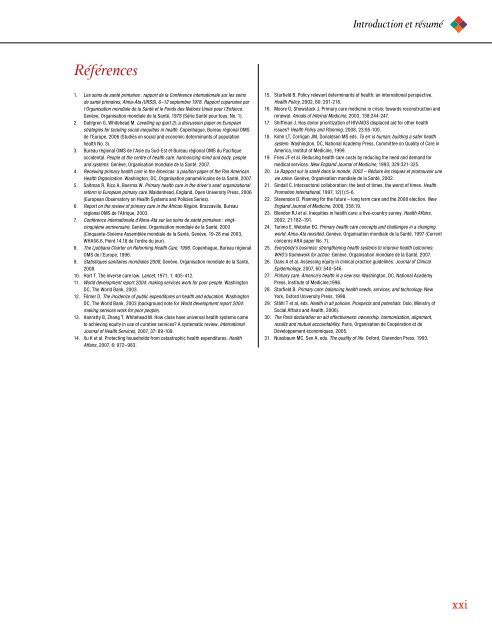Maintenant plus que jamais - World Health Organization
Maintenant plus que jamais - World Health Organization
Maintenant plus que jamais - World Health Organization
You also want an ePaper? Increase the reach of your titles
YUMPU automatically turns print PDFs into web optimized ePapers that Google loves.
Introduction et résuméRéférences1. Les soins de santé primaires : rapport de la Conférence internationale sur les soinsde santé primaires, Alma-Ata (URSS), 6–12 septembre 1978. Rapport coparrainé parl’Organisation mondiale de la Santé et le Fonds des Nations Unies pour l’Enfance.Genève, Organisation mondiale de la Santé, 1978 (Série Santé pour tous, No. 1).2. Dahlgren G, Whitehead M. Levelling up (part 2): a discussion paper on Europeanstrategies for tackling social inequities in health. Copenhague, Bureau régional OMSde l’Europe, 2006 (Studies on social and economic determinants of populationhealth No. 3).3. Bureau régional OMS de l’Asie du Sud-Est et Bureau régional OMS du Pacifi<strong>que</strong>occidental. People at the centre of health care: harmonizing mind and body, peopleand systems. Genève, Organisation mondiale de la Santé, 2007.4. Renewing primary health care in the Americas: a position paper of the Pan American<strong>Health</strong> <strong>Organization</strong>. Washington, DC, Organisation panaméricaine de la Santé, 2007.5. Saltman R, Rico A, Boerma W. Primary health care in the driver’s seat: organizationalreform in European primary care. Maidenhead, England, Open University Press, 2006(European Observatory on <strong>Health</strong> Systems and Policies Series).6. Report on the review of primary care in the African Region. Brazzaville, Bureaurégional OMS de l’Afri<strong>que</strong>, 2003.7. Conférence internationale d’Alma-Ata sur les soins de santé primaires : vingtcinquièmeanniversaire. Genève, Organisation mondiale de la Santé, 2003(Cinquante-Sixième Assemblée mondiale de la Santé, Genève, 19‐28 mai 2003,WHA56.6, Point 14.18 de l’ordre du jour).8. The Ljubljana Charter on Reforming <strong>Health</strong> Care, 1996. Copenhague, Bureau régionalOMS de l’Europe, 1996.9. Statisti<strong>que</strong>s sanitaires mondiales 2008, Genève, Organisation mondiale de la Santé,2008.10. Hart T. The inverse care law. Lancet, 1971, 1: 405-412.11. <strong>World</strong> development report 2004: making services work for poor people. WashingtonDC, The <strong>World</strong> Bank, 2003.12. Filmer D. The incidence of public expenditures on health and education. WashingtonDC, The <strong>World</strong> Bank, 2003 (background note for <strong>World</strong> development report 2004:making services work for poor people).13. Hanratty B, Zhang T, Whitehead M. How close have universal health systems cometo achieving equity in use of curative services? A systematic review. InternationalJournal of <strong>Health</strong> Services, 2007, 37: 89-109.14. Xu K et al. Protecting households from catastrophic health expenditures. <strong>Health</strong>Affairs, 2007, 6: 972–983.15. Starfield B. Policy relevant determinants of health: an international perspective.<strong>Health</strong> Policy, 2002, 60: 201-218.16. Moore G, Showstack J. Primary care medicine in crisis: towards reconstruction andrenewal. Annals of Internal Medicine, 2003, 138:244-247.17. Shiffman J. Has donor prioritization of HIV/AIDS displaced aid for other healthissues? <strong>Health</strong> Policy and Planning, 2008, 23:95-100.18. Kohn LT, Corrigan JM, Donaldson MS eds. To err is human: building a safer healthsystem. Washington, DC, National Academy Press, Committee on Quality of Care inAmerica, Institut of Medicine, 1999.19. Fries JF et al. Reducing health care costs by reducing the need and demand formedical services. New England Journal of Medicine, 1993, 329:321-325.20. Le Rapport sur la santé dans le monde, 2002 – Réduire les ris<strong>que</strong>s et promouvoir unevie saine. Genève, Organisation mondiale de la Santé, 2002.21. Sindall C. Intersectoral collaboration: the best of times, the worst of times. <strong>Health</strong>Promotion International, 1997, 12(1):5-6.22. Stevenson D. Planning for the future – long term care and the 2008 election. NewEngland Journal of Medicine, 2008, 358:19.23. Blendon RJ et al. Inequities in health care: a five-country survey. <strong>Health</strong> Affairs,2002, 21:182–191.24. Tarimo E, Webster EG. Primary health care concepts and challenges in a changingworld: Alma-Ata revisited. Genève, Organisation mondiale de la Santé, 1997 (Currentconcerns ARA paper No. 7).25. Everybody’s business: strengthening health systems to improve health outcomes:WHO’s framework for action. Genève, Organisation mondiale de la Santé, 2007.26. Dans A et al. Assessing equity in clinical practice guidelines. Journal of ClinicalEpidemiology, 2007, 60: 540‐546.27. Primary care. America’s health in a new era. Washington, DC, National AcademyPress, Institute of Medicine,1996.28. Starfield B. Primary care: balancing health needs, services, and technology. NewYork, Oxford University Press, 1998.29. Ståhl T et al, eds. <strong>Health</strong> in all policies. Prospects and potentials. Oslo, Ministry ofSocial Affairs and <strong>Health</strong>, 2006).30. The Paris declaration on aid effectiveness: ownership, harmonisation, alignment,results and mutual accountability. Paris, Organisation de Coopération et deDéveloppement économi<strong>que</strong>s, 2005.31. Nussbaum MC, Sen A, eds. The quality of life. Oxford, Clarendon Press, 1993.xxi

















